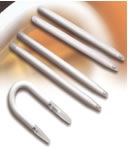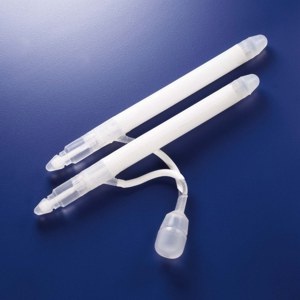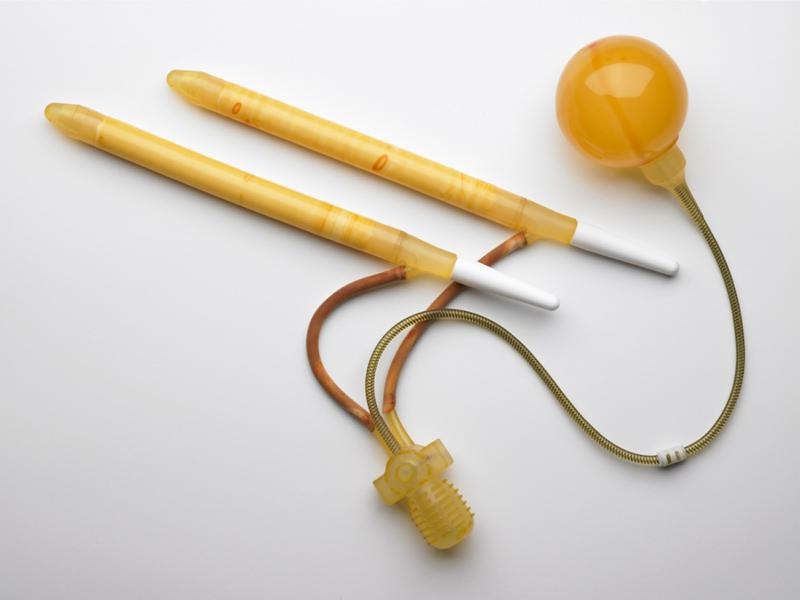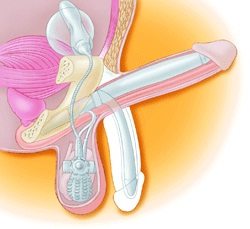
Meet Professor ChungAssociate Professor Chung is a urological surgeon specialising in andrology, microsurgical, and urological prosthetic surgery. Contact(07) 3832 1168 |
Penile prosthesisPenile prosthesis surgery involves the implantation of an erectile device within the penis and is the most effective treatment for erectile dysfunction because it allows the man to have an (artificial) erection anytime he wants and as long as he wants to keep the erect penis up. There are two main types of penile prostheses, the Semi-Rigid implant and the Inflatable penile implant. Semi-Rigid implants involve placing a semi-rigid rod into the penis. After having this operation you will have a semi-permanent erection, although this will not be as firm as your previous erections, it is adequately suitable for sexual intercourse. It is also flexible enough to be pulled down and tucked away when you are clothed, thereby avoiding any unwanted attention or embarrassment.
Inflatable implants can be a 2-piece or 3-piece models. The 3-piece inflatable penile prosthesis closely simulates a natural penile erection and most men prefer this device. It involves the insertion of two cylinders into the penis and a reservoir of 60-100mls of saline deep behind the pubic bone. A pump and valve are inserted into the scrotum allowing the saline to be pumped into the penis, thus producing an erection. When an erection is no longer needed the valve can be released allowing the saline to drain back into the reservoir and the penis to become flaccid (soft). Penile prosthesis implant has been around since the early 1970s and there have been considerable advances in both surgical technique and device technologies. It is safe, effective and durable, and is associated with excellent patient and partner satisfaction. There is no doubt that a penile prosthesis implant offers the man a guaranteed erect penis anytime and for as long as he wants his erect penis for sexual activity. Prof. Chung is the leading author of the International Penile Prosthesis Implant Forum on the consensus statement and evidence-based surgical recommendations for the inflatable penile prosthesis implantation - Chung E, Bettocchi C, Egydio P, Love C, Osmonov D, Park S et al. The International Penile Prosthesis Implant Consensus Forum: Clinical recommendations and surgical principles on the inflatable 3-piece penile prosthesis implant. Nat Rev Urol. 2022;19(9):534-546 What preparation is required?Since the penile prosthesis implant is performed under general anaesthesia, you should have nothing to eat or drink for 6 hours prior to treatment. Regular medications can be taken with a sip of water with the exception of blood thinning agents (eg. warfarin, aspirin, clopidogrel) or non-steroidal anti-inflammatories which need to be stopped for 7-10 days. A mid-stream urine (MSU) test is required to ensure the urine is sterile before treatment is undertaken. What do I need to bring to surgery?
What happens in the operating room?You will meet your anaesthetist prior to surgery who will take a thorough medical history. Your procedure will be performed under general anaesthesia with an anti-microbial cover. The genital area will be shaved and an alcoholic povidine surgical antiseptic will be applied to minimise microbial skin colonisation. What are the risks?Since penile prosthesis implant involves the insertion of a foreign device, strict microbial prophylaxis and surgical techniques are paramount. When performed by an expert surgeon, a penile prosthesis implant is a safe procedure. Specific complications involve:
What to expect afterwards?You are usually required to stay overnight to receive intravenous antibiotics for 24 hours postoperatively. Your urinary catheter and surgical dressing will be removed the next morning after your surgery. When you are comfortable and passing urine satisfactory, you will be discharged with 14 days of oral quinolones antibiotics. At home, you should rest and avoid strenuous physical exertion for 4-6 weeks. During this time, your penile prosthesis remains deflated and any sexual activity is discouraged. It is important that you take regular painkillers to stay on top of your pain and to avoid the pain becoming severe. Ice packs and tight supportive underwear are helpful to minimise scrotal bruising and swelling. Follow-upYou will be contacted or have an appointment the following week in order to check on your progress. The recycling of the penile prosthesis occurs at your second follow-up with Prof. Chung at 4 weeks postoperatively. During that visit, you should take simple oral analgesia prior to the appointment as you might experience local pain when the penile prosthesis is activated for the first time. Prof. Chung will provide you with instructions on penile prosthesis rehabilitation to maximise your prosthesis clinical outcome.
Meet Professor ChungAssociate Professor Chung is a urological surgeon specialising in andrology, microsurgical, and urological prosthetic surgery. Contact(07) 3832 1168 |









